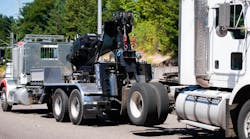Schneider National’s recent announcement of an 8% to 13% pay increase for drivers in its dry van TL division is indicative of a longer-term compensation trend now firming up throughout the trucking industry, experts say.
“We’re really just at the start of this,” Jonathan Starks, director of transportation analysis for research firm FTR Transportation Intelligence, told Fleet Owner.
“It’s been about a year since changes to hours of service (HOS) rules went into effect and now carriers have the data they need to show to shippers why these pay increases are necessary,” Starks explained. “They’ve needed to make these pay increases for a while, but they are doing it now because they have the evidence to make their case.”
Dave Geyer, senior VP for Schneider’s dry van TL division, noted that “strong customer demand is providing record miles for drivers to maximize their available hours” and also added that other “ancillary” benefits are being made available as well.
For example, Schneider drivers in select divisions and areas may also benefit from a sign-on bonus up to $7,500, tuition reimbursement of up to $6,000, as well as a mix of more “home time” focused job options.
“It’s not just about figuring out how much more pay will be needed to attract more into the truck driving career,” FTR’s Starks emphasized. “It’s about benefits and home time, too. And home time is a form of compensation, as it imposes operational costs on a carrier.”
Sandeep Kar, global director of automotive and transportation research at global consulting firm Frost & Sullivan, added that while driver compensation has largely taken a back seat to fuel efficiency in total cost of operation (TCO) calculations in recent years, that will change by 2022.
“In 2013, driver wages represented 28% of every $100 spent by a fleet, with benefits at 9% with fuel at 33%,” he told Fleet Owner. “By 2022, driver wages will represent 31% of every $100 spent by a fleet, benefits 11%, while fuel will fall to 29%; largely because trucks are now much more fuel efficient.”
Kar believes driver pay is a “major issue” in the trucking industry that’s overdue for change.
“We expect an industry-wide correction because the pool of available drivers is shrinking and trucking needs to attract younger and more technology-savvy to become drivers,” he said. “Thus the industry needs to raise wages.”
Paper Transport is another TL carrier initiating pay increases; in its case of up to 5% for both its dedicated and regional one-way drivers piloting its 400-unit fleet, largely because polls conducted by the company indicate higher pay rates are critical.
“We have heard shipper calls to grow capacity as an industry,” noted Jeff Shefchik, president of Paper Transport; adding that his company’s pay raise goes into effect Oct. 19. “Leading in driver pay … helps us recruit and retain the best people, ultimately improving the quality and cost of the service we deliver to our customers.”
FTR’s Starks adds that such pay increase announcements also highlights the confidence on the part of carriers that they can win freight rate hikes significant enough to fund higher driver wages.
“It’s a little like a chicken and egg situation: they need to announce these pay increases, then obtain the rate increases in order to support them,” he explained. “But due to the tight capacity situation, what shippers experienced last winter due to weather-related capacity shortages, and the data provided about the impact of HOS changes, carriers are confident they can win that rate support.”



